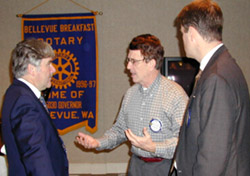|
|

Bill Wilkerson (L) gets an earful from Doug Cameron [C] as Tim Moriarty looks on.
|
A group of private landowners, in concert with Governor Gary Locke’s statewide Salmon Recovery Plan, worked quietly for two
-and-half years to achieve the first-ever accord to save salmon. Called the Forest & Fish Plan and Iinitiated by Washington’s private forest landowners, the Plan is the result of several years of
collaboration with scientists and policy makers from federal, state, county, and tribal governments. Bill Wilkerson, Executive
Director of the Washington Forest Protection Association, gave the details of the Plan at Friday’s membership meeting.
Wilkerson, a former head of the State Department of Revenue, has spearheaded the movement toward solving the salmon issue. “Back in
1995, the WFPA recognized that we must work to form new thinking on how to stave off listing the salmon as endangered. We recognized our
responsibility as forest landowners to establish procedures that would meet standards of the Federal Endangered Species Act and the Clean
Water Act. On June 7, 1999, Governor Locke signed a bill passed by the Washington legislature, and the Forest & Fish Plan became reality.”
The new plan encompasses over 8 million acres of privately-owned land in
Washington, 4.5 million of which is owned by members of the WFPA. Wilkerson said the need for a negotiated long-term plan was apparent, as
a result of the spotted owl court decision. “The court set up ‘owl circles,’ from the start, an area encompassing 70 acres around old growth timber.
Since that time, the circle has grown to 3,500 acres. The bird – which hardly anyone had heard of before that time (1992) – only lives on timber
land, and the court decision was absolutely devastating to the timber industry and timber towns.”
Wilkerson said his association members “cared about salmon and wanted
to solve the issue in another way. We joined the effort to find a plan that would fit everyone’s needs. In early 1999, we came to an agreement, and
what we’ve got is a plan that guarantees a set of standards for the next 50 years.”
Wilkerson refers to the buffer along streams. The new legislation specifies
a 110-120-foot wide buffer back from streams, where the trees and foliage are allowed to grow. This means that 15% of all land in the state has been
set aside for this purpose … 60,000 miles of streams are affected. “So, old growth timber will grow along side all our streams, making an improved habitat for spawning salmon.”
The new law also speaks to roads within forested areas, setting standards
for no sediment reaching streams. Unstable and steep slopes are also noted in the Plan. Wilkerson praised the Bellevue Breakfast Rotary Club
for its activity in improving the habitat along the Sammamish Slough, a six-year project of Rotary’s Preserve Planet Earth initiative. “Your efforts will
pay off in salmon enhancement, remembering that much of the land along streams that feed Lake Sammamish is owned privately and are included in the Plan.”
The WFPA Director said it’s important that all citizens recognize the need
for establishing the Plan. “Washington State depends heavily on a healthy timber harvest. We need to keep the State in the business of growing
trees. Timber lands, both public and private, must participate in the program of restoring salmon runs. A well-managed tree farm strategy will accomplish that.”
“The day is coming when all people will be in two businesses: their own
livelihood and the environment … 85% of our citizens want salmon restored, and 92% want clean, clear, cool water. I would urge all of you to
support this new agreement now. Salmon will not make it through a long, extended fight. Act now and respond now. Salmon are worth protecting. If
we can’t step up now when the need is demonstrated, then we are saying something about ourselves,” Wilkerson concluded.
The Washington Forest Protection Association is located in Olympia. For further information, call (360) 352-1500 or go to their website. Another
website of interest: www.forestsandfish.com.
Thanks to Tim Moriarty for his introduction.
|